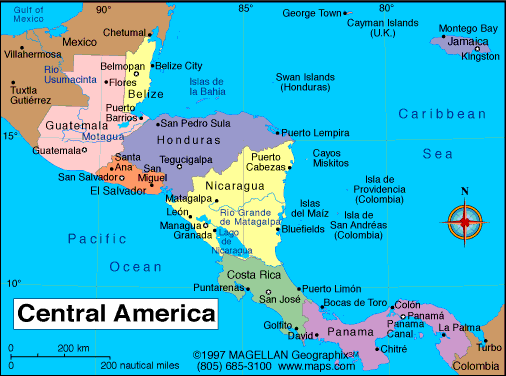 -Toma de poder: last January, Daniel Ortega was inaugurated as president, along with his wife, Rosario Murillo (who has been very involved in all aspects of campaigning and governing). They were surrounded by dignitaries, most notably and loudly from Venezuela and Bolivia. The promises, always in non-threatening hues of yellow and pink, have been for reconciliation and peace. Constant allusions are made to the re-triumph of the 1979 Sandinista revolution. Below is a picture of the National Palace with a large banner dedicated to Carlos Fonseca, the brains behind the Sandinista party, assuring him that they are advancing in the revolution.
-Toma de poder: last January, Daniel Ortega was inaugurated as president, along with his wife, Rosario Murillo (who has been very involved in all aspects of campaigning and governing). They were surrounded by dignitaries, most notably and loudly from Venezuela and Bolivia. The promises, always in non-threatening hues of yellow and pink, have been for reconciliation and peace. Constant allusions are made to the re-triumph of the 1979 Sandinista revolution. Below is a picture of the National Palace with a large banner dedicated to Carlos Fonseca, the brains behind the Sandinista party, assuring him that they are advancing in the revolution.
-Cooperación internacional: this phrase usually refers to the oil that Nicaragua is getting from Venezuela and whatever else goes along with this partnership.
-"Arriba los pobres del mundo!" is a slogan seen everywhere in government propaganda. It usually also includes some reference to the 1979 Sandinista revolution and a photo of the balding Daniel Ortega (former Sandinista Comandante and current President) holding up his hand in . . . triumph? battle? a political wave? The saying could be translated, "Rise up, poor of the world!" or "The poor of the world are now on top!" Some cynical Nicaraguans insert the word "de" after "arriba," making the slogan imply that Daniel Ortega has lifted himself up from the poor of the world.
-Cero hambre (zero hunger) is a policy implemented by this Sandinista government to give goats/cows/chickens and seed to people in the most rural and impoverished parts of Nicaragua. Plus: this is a great and sustainable idea if people know how to use these gifts (and in many places they are being educated for this). Potential negatives: 1) some people do not have the tools to make these gifts work for them over the long haul. 2) it is unclear if these are being distributed to all people, or only government supporters.
-CPCs are the Citizen Power Councils that were set up by the Sandinista government in each community. There is now a controversy over the administration's attempt to make the CPCs part of the executive branch. Plus: in many communities people have been empowered, are organized, and feel they have a voice in the government. Controversy: some people have accused the councils of being set up to monitor communities (especially opposition).
-Government restructuring (politically): There has been some push to change the constitution to a more parliamentary system, with a prime minister and direct geographic representation (instead of the current system of the National Assembly being selected based on percentage of votes that the party receives in the presidential election).

-Government restructuring (physically): In the 1990s, the liberal government of Arnoldo Aleman decided to put a fountain and garden outside the National Palace and old cathedral, where the Plaza de la Revolución used to be. This year, the new government tore out the fountain and garden, spending thousands of government dollars to repave the Plaza so that it could be like it was in the time of the revolution.

-Aborto terapeutico/therapeutic abortion: this has been a political issue for the last 2 years or more here. Currently, the law criminalizes therapeutic abortion, meaning that the penalty for abortion to save the life of the woman is 3 years in prison for the woman and doctor. This has been in the news especially with the pregancies of young girls (at least one case of a 9 year old). Nicaragua is one of the only countries in the world with a law like this, and there are many protests against it. Many would say that it was passed before the last election to gain support from the Catholic church. Catholics and Evangelicals, normally at odds, have joined together to defend the law.
Nicaragua, Nicaragüita! A country of contrasts . . .

No comments:
Post a Comment